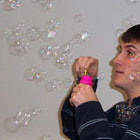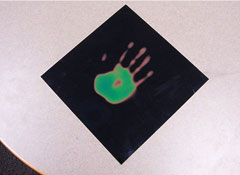Education and Outreach: Nanotechnology Activity Guides
Liquid Crystal Sensors
Audience: Middle school class
Time Needed: 50 minutes
Objectives:
- Understand how liquid crystals (LCs) relate to other phases of matter (liquid, solid, gas)
- Observe that liquid crystals reflect many different colors (wavelengths) of light
- Learn that thermally sensitive LCs twist and turn (change pitch & orientation) at different temperatures, which changes the particular color of light that they reflect
- Learn that just like some LCs can measure temperature, others can 'sense' particular chemicals and biological agents
- Explore how LC sensors can be used to detect changes that cannot be seen with the naked eye
- Brainstorm particular applications of LC sensors
Related Wisconsin Model Academic Science Standards:
- A.8.6 Use models and explanations to predict actions and events in the natural world
- C 8.1 Identify questions they can investigate using resources and equipment they have available
- D.8.2 Use the major ideas of atomic theory and molecular theory to describe physical and chemical interactions among substances, including solids, liquids, and gases
- D.8.3 Understand how chemical interactions and behaviors lead to new substances with different properties
- ELA C.8.3 Participate effectively in discussion
Activity Materials:
- One bottle bubbles per group of 2-4 students (see http://www.zurqui.co.cr/crinfocus/bubble/bubble.html)
- One sealed vial heat-sensitive liquid crystals per group (see http://mrsec.wisc.edu/edetc/cineplex/LC_prep.html)
- Liquid crystal thermal sheets for three different temperature ranges, cut into 3" x 6" rectangles (each group should get three sheets total – one sheet of each kind)
- Hand warmers (one per group)
- Ice packs or ice inside Zip-lock bags (one per group)
- Refrigerator magnets in the shape of words and/or other geometric shapes , placed inside opaque envelopes (several per group, but groups could also share)
- Overhead transparencies (pdf)
- Student worksheets (one worksheet per student):
Brainstorming the Properties of Liquid Crystals (pdf)
Liquid Crystals as Sensors (pdf)
Temperature Sensitive Liquid Crystals (pdf)
Activity Instructions:
Intro to Nano (optional)
Introduce the concept of "nano." For ideas, see "Nanoscale Activities"
at http://www.mrsec.wisc.edu/edetc/IPSE/educators/.
Introduction: Liquid Crystal (LC) is a Phase of Matter (5-10 min)
Have students brainstorm the different properties of liquids, solids (crystals),
and gases. Note that liquid crystal (LC) is a special phase of matter and have
students brainstorm its properties (e.g., liquid-solid hybrid) based on the
discussion of liquids and solids.
Optional: Have students arrange the phases of matter based on randomness at the atomic level. Note that atoms in a liquid crystal phase are less random than atoms in a liquid phase and more random than atoms in a solid phase.
 Bubble
Activity: LCs Reflect Different Colors of Light (10 min)
Bubble
Activity: LCs Reflect Different Colors of Light (10 min)
Have students blow bubbles, a particular type (i.e. lyotropic) of LC, and make
observations about how their colors change from when they were brand new to
right before they pop. (Bubbles will be less colorful as they dry out and get
closer to popping.) Note that bubbles reflect all the full spectrum of colors
in a rainbow.
Introduce Temperature Sensitive LCs (10 min)
 |
 |
Note that there are many different types of LC – including LCs that respond
to temperature changes. Have students rub glass vials containing temperature
sensitive LCs and make observations, noting that heat is transferred to the
LCs from the students’ hands. Ask students why these LCs might change color
at different temperatures.
CAUTION: Do not allow students to open the vials. This type of liquid crystal is toxic.
Experiment: Compare Different LCs at Different Temperatures (15 min)
Give the students liquid crystal thermal sheets that change color in response to different temperature ranges. Have them use their hands with or without hand warmers to order the thermal sheets from low temperature sensitive to high temperature sensitive.
 |
 |
LC Sensor Activity: LC Sensors Can "See" What Our Eyes Can't (15 min)
Use LC sensors to see the invisible thermal print that your hand leaves when
removed from a tabletop. Place a hand warmer over an envelope containing a magnetic
shape/message. Remove the hand warmer and wait a few seconds before placing
on a high temperature sensitive liquid crystal sheet. Note the appearance of
the message on the LC sheet.
Have the students use their thermal sheets to decode other magnetic shapes/messages
hidden inside envelopes. They may find the hand warmer and ice pack useful.

Brainstorm Potential Uses for LCs and LC Sensors (optional)
Have students come up with their own ideas for how LC products and sensors might
be used in the real world.
Required Background Information:
Phases of Matter
The atoms of solid are compact with their positions and orientations fixed,
whereas those of a liquid can move around, assuming the shape of whatever container
the liquid is in. Liquid crystals also have the fluidity of a liquid but their
movement is coordinated along the same direction. Therefore, one atom in the
liquid crystal phase has an impact on the orientation of another atom close
by. Liquid crystals are made by boiling certain kinds of organic compounds and
then, subsequently cooling them. For a more in-depth look at the structure of
liquid crystals, see the Background
for the Teacher transparencies.
Nano
Nano is a prefix that means one-billionth of something. For example, nanometer
is one-billionth of one meter. The nanoscale is useful in describing the size
of atoms, which are subunits of matter. Nanotechnology refers to the design
of technology and tools at the nanoscale to manipulate and/or visualize atoms.
Phases of matter differ in how much freedom the atoms have in moving around.
For example, when atoms have very little freedom, the overall structure is rigid
as in a solid.
Light
Light is wave. Different colors of light are characterized by a different wavelength,
which is on the order of 400 to 700 hundred nanometers in the visible spectrum.
White light consists of all the colors of the rainbow. When white light hits
the atoms of a liquid crystal, the orientation of these atoms may allow only
certain wavelengths or colors of light to be reflected back to our eyes.
Supplemental Materials:
- Teacher's Guide: Materials and Where to Find Them (pdf)
- Transparencies: Background for the Teacher (pdf)
- Transparencies: Teaching Slides (pdf)
- Worksheet: Brainstorming the Properties of Liquid Crystals (pdf)
- Worksheet: Liquid Crystals as Sensors (pdf)
- Worksheet: Temperature Sensitive Liquid Crystals (pdf)
References:
- Elston, S. and Sambles, R. 1998. The Optics of Thermotropic Liquid Crystals.
- How Liquid Crystal Displays Work. URL: http://www.howstuffworks.com
- PLC Virtual Laboratory. URL: http://plc.cwru.edu/tutorial/enhanced/lab/lab.htm
- Soap Basics. URL: http://home.earthlink.net/~marutgers/science/soapbasics/soapbasics.html
- Sonin, Andrei, A. 1998. Freely Suspended Liquid Crystalline Films.
- What Are Liquid Crystals. URL: http://www.lassp.cornell.edu/sethna/LiquidCrystals/BluePhase/What_Are_Liquid_Crystals.html
Authors:
IPSE Interns: Julie He, Jeffrey Maxwell
IPSE Leadership Team: Wendy C. Crone, J. Aura Gimm, Wendy deProphetis, Greta Zenner, and Tom Derenne
| Return to this activity's summary page |
The Nanotechnology Activity Guides are a product of the Materials Research Science and Engineering Center and the Internships in Public Science Education Project of the University of Wisconsin - Madison. Funding provided by the National Science Foundation.


